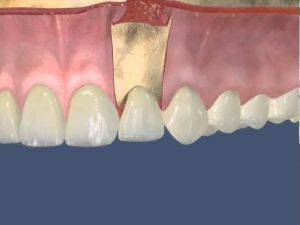 Resection of the apex of the tooth root( apexectomy) is one of the procedures for maintaining the integrity of the dentition, by restoring the basic functions of the damaged tooth, requiring surgical intervention.
Resection of the apex of the tooth root( apexectomy) is one of the procedures for maintaining the integrity of the dentition, by restoring the basic functions of the damaged tooth, requiring surgical intervention.
Unlike the old way of solving this problem, the tooth is not completely removed, but only the focus of inflammation is performed, by cutting the gums in the upper part of the root.
Contents
- When the operation is performed
- Sometimes this method is useless. ..
- How is the preparation for the procedure
- Step by step the whole operation of
- To reveal the nuances will help the reviews
- Price issue
When the operation
is performed The operation of tooth resection is carried out in the presence of certain symptoms that allow determining the urgencyits conduct. The most common cause is periodontitis.
In the manifestation of this ailment, a cyst is formed on the tip of the tooth root, in the form of dense fibrous walls filled with pus. If the pockets of inflammation are not yet large, and only begin to expand, then this process is completely reversible and without surgical intervention.
If, the foci reach more than 1 cm in diameter, resection is necessary, and the sooner the better. Otherwise, ignoring the cyst can lead to serious complications, such as: the flow of gums and cheeks, acute, continuous pain in the area of the aching tooth, and, as a consequence, the discharge of purulent springs into the oral cavity.
In addition to diseases, the need for resection can also be affected by careless root canal filling. Before carrying out the 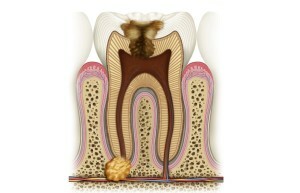 sealing operations, the roots of the tooth should be completely depulled. Only after this, it is possible to conduct the canal filling, including even the tops of the roots.
sealing operations, the roots of the tooth should be completely depulled. Only after this, it is possible to conduct the canal filling, including even the tops of the roots.
If there is an untreated section of the canal, an inflammatory process may begin in this area, which, of course, will lead to the formation of a cyst. Get rid of inflammation, you can only two ways.
The first method is to remove the sealed coating from the surface of the inflamed canal, clean the foci of the disease, and reverse the filling, without the admission of a recurrence of the gaps. But, this option is quite dangerous, since, if it is not carried out correctly, it can provoke perforation, and as a consequence, loss of one or even several teeth.
Therefore, recently, the second method has become more preferable - resection. At the same time, not all the filling material is removed from the dental canal, but only the part that was covered poorly.
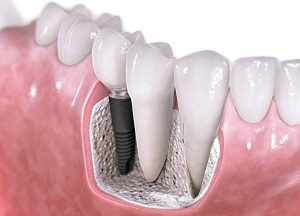 Another reason for this operation may be damage to the dental root. It can occur as a result of installing or removing a metal pin located in the channel.
Another reason for this operation may be damage to the dental root. It can occur as a result of installing or removing a metal pin located in the channel.
More rarely, the inflammation begins to progress after a long time, after sealing, when the tooth is already installed crown. In this case, to facilitate the procedure for removing the filling, the crown, together with the underprocessed root, can be cut by resection.
Sometimes this method is useless. ..
Sometimes, apexectomy is not relevant, and its implementation is not necessary. For example, if the tooth root is completely destroyed, or if its granuloma is extensive, the patient should only have complete removal of the inflamed organ.
Also, chronic periodontitis, which is in an acute stage of development, is also treated. With a strong mobility of a sick tooth, resection, too, will be powerless, or even, or rather, it is useless.
How is preparation for
procedure? Although the operation of root resection is considered one of the most traumatic, before the conduction, special preparation of the patient is necessary.
First and foremost, it includes the full sealing of all the dental canals, which must be performed, at least 24 hours prior to resection.
Further, it is necessary to follow the reaction by the channel to the filling material. If no signs of inflammation are found within a day, then you can safely step into the procedure. Well, in case the inflammation begins to manifest itself, you need to carefully review the entire surface of the tooth canal, for the presence of gaps.
If a foci of inflammation is detected, carry out a complete purge from the purulent discharge, and refill the canal.
Step by step the whole operation of
After carrying out the sealing, you can proceed directly to the resection itself:
- The first step is to release to the top of the tooth root of .This is done by forming a small incision on the
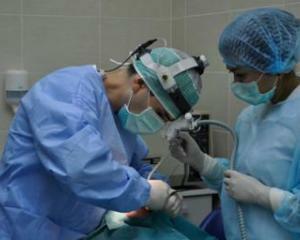 gum. The incision is made in such a way that the mucous area of the tissue is completely exfoliated from the bone.
gum. The incision is made in such a way that the mucous area of the tissue is completely exfoliated from the bone. - The next step is to drill a small diameter hole in the gingival bone. This is done using a drill, with a spherical or fissure type of boron.
- If, when drilling a hole, a granuloma is found, then it must be removed , and, together with the granulation tissue. This is done with extreme caution, since near the upper molars, on which the process of removing the granuloma will be performed, are the maxillary sinuses, and the nasal cavity. The removal is done using a curettage spoon.
- Further, in order to fully open the access to the top of the tooth roots of the , you can use a bit, or a hammer. With these tools, it is necessary to knock out the wall located on the dental alveolus. This process will allow the dentist to completely expose the root of the aching tooth. Thus, when sealed, the probability that a zone will be missed is reduced to zero.
- The next step is the detection of the top of the root, and the cyst formed on it, through the previously made hole in the bone tissue. The place where the cyst is located is neatly cut off, and pulled out with tweezers.
- In the place where the top of the root used to be, there will be an empty wound, which must be filled with .This is done using synthetic bone tissue. Putting it in the wound hole, the healing process will be significantly accelerated, and the defect in the form of a dent, after the operation, will not be noticeable.
- Now, you can proceed with to stitch the wound .The sutures are applied directly to the site of the mucous membrane incision. After the end of the operation, in between the seams, a special "drainage" is inserted, which serves to divert the syphilis from the damaged gum area.
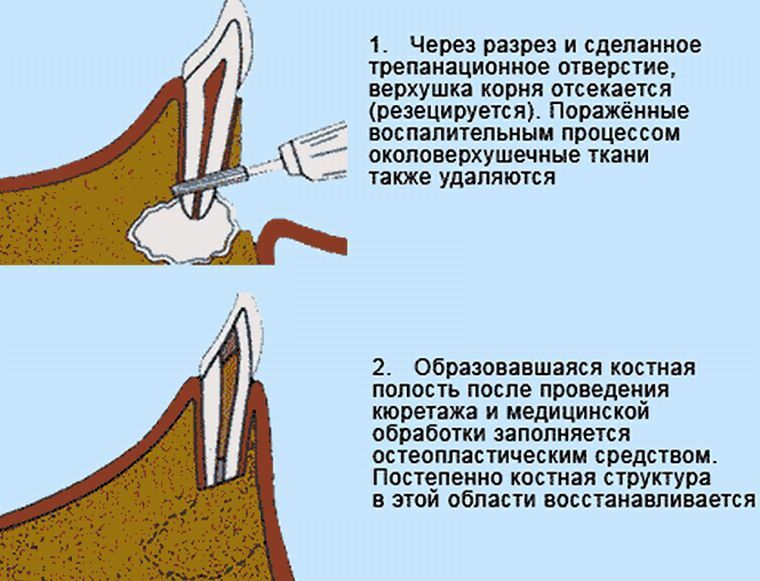
The video schematically shows the process of resection of the apex of the tooth root:
Expand the nuances will help reviews
Resection of the tip of the tooth root, sometimes, without alternative operation, which is confirmed by numerous reviews.
Last year, I decided to make an apexectomy. More precisely, not even I decided, but made me a piercing pain in the gum area, which, at first, was pulsating, and then turned into a constant, aching pain. I was an excellent specialist. The operation went pretty quickly, in about 15 to 20 minutes. Painful sensations, during the procedure, I did not feel.
Of course, after the end of the operation, for a while there was a significant numbness on the left side of the face( it was on the left side that there was a sick tooth).Also, for several hours, from time to time the saint acted in small quantities.
In general, I was satisfied with the work done. The pain has passed, and what is very important - the tooth has remained in place, and still can safely perform its functions.
Karim, 41
Yesterday I went to dentistry about the resection of the upper part of the dental root. I have heard about this procedure, and only from the light side, and now, it fell and I checked it for work. The operation was "in one fell swoop".The dentist, spent about 30 minutes to remove the cyst, but at the same time, absolutely painless. The hole was not large, and there were only two stitches.
I was afraid of tooth filling, so that I did not miss anywhere in the area. But, as it turned out - in vain. This procedure is brought, almost to automaticity. After 3 months, the root began to show signs of life, and sensitivity appeared. Edema after the operation, have passed, literally in 2 days.
Vasily, 39
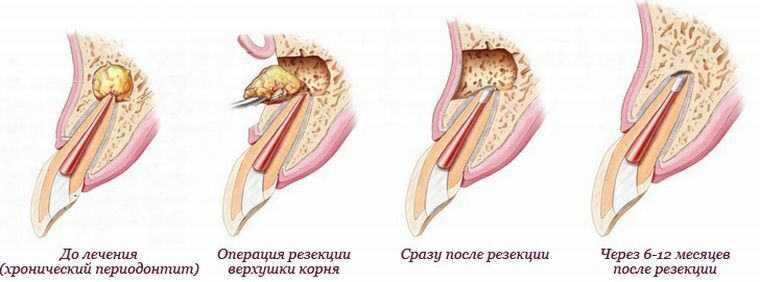
Price question
To date, the cost of this procedure depends on the clinic in which it is conducted, from the region and the region, while not depending on the stage of the disease. On average, the price of resection is quite affordable, and ranges from 4,000 to 8,000 rubles.
The cost of the service includes not only the operation itself, but an anesthetic. Moreover, the preparation and the variant of an anesthetic, you can choose yourself( from the list suggested by the expert).
Having become more familiar with the procedure of resection, it can be concluded for myself that ignoring the cyst disease is not permissible. In cases of the first symptom of the manifestation of the disease, do not hesitate to go to the dentist for this operation.
Given such a human factor as pain, it is worth remembering that with the advanced stage of the disease, the pain syndrome becomes only stronger, and treatment, as noted in the reviews, is absolutely painless, as well as the recovery period.
That is, if you are afraid of a toothache, it is better to eliminate the focus of inflammation immediately, if they are tormented for a long time.
